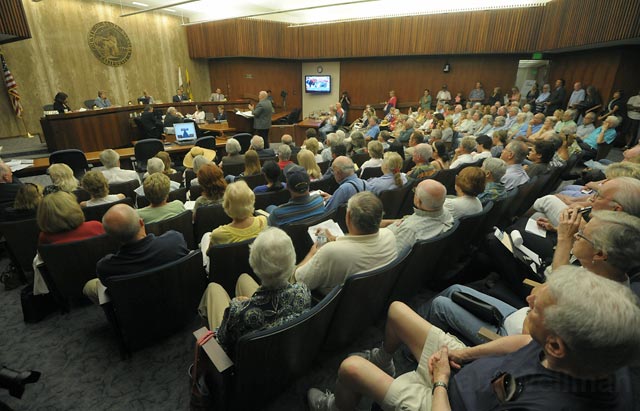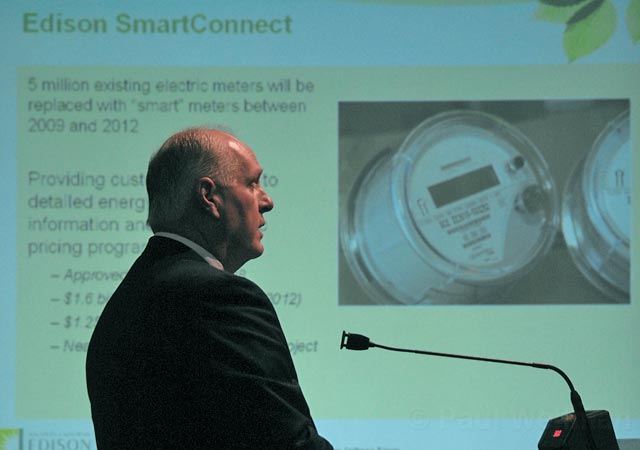Smart Meter Smack Down
Utility Companies Blistered from All Sides over Eco-Friendly Energy Meters

A new high-tech electric meter that promises to help California households reduce energy consumption by as much as 12 percent and to reduce greenhouse gas emissions by more than 350,000 tons a year got relentlessly bashed, thrashed, and trashed by the outspokenly hostile and suspicious crowd that jammed the county supervisors’ chambers for a marathon hearing Tuesday afternoon. Despite the eco-friendly origins of the so-called “smart meters,” not one environmental activist showed to voice support. It was truly the sound of one hand slapping as 45 speakers—representing a fusion of anti-Big Government forces with the anti-Big Corporation crowd—signed up to vilify the new device that was approved by the California Public Utility Commission (CPUC) in 2008 and that will be installed throughout Santa Barbara homes next February.
The speakers blasted the new meters—which allow utility managers and consumers to track energy use on an hourly basis—as an invasion of privacy, an assault on constitutional protections, and the embodiment of “Big Brother” predicted by writer George Orwell in his dystopian police state fantasy 1984. But mostly, the speakers expressed profound—and often anguished—concern about the health risks associated with the low-level radio waves that the meters transmit throughout the course of a day. Many speakers noted that the World Health Organization had placed smart meters on its official list of potential carcinogens in just the past month. (Santa Barbara County Health Director Takashi Michael Wada countered that coffee is also on the same list.) Others argued that such radiation can play havoc with the finely tuned electronics of pacemakers, cause migraines, induce insomnia, and otherwise afflict those prone to electronic sensitivities.

Wada also noted that, according to recent scientific assessments, the radiation levels associated with the new meters falls well within the Federal Communications Commission guidelines, and considerably less than the amount given off by cell phones. That hardly assuaged anyone, as one speaker noted, “Look how long the tobacco industry told us that tobacco was safe.” Another shrugged off the cell phone comparison, countering, “If I want to choose to use a cell phone, it’s my choice. I can’t choose to turn off my smart meter.” Many were upset as much by the number of radiation sources as by the quantity. John Wright, a dentist for 57 years, said there was a good reason why dental patients wear lead aprons when getting X rays, “and it’s not just to keep us warm.” A few suggested disapprovingly that the new meter technology originated with the United Nations rather than any state or federal mandate. They expressed concern that hackers could break past any protective firewall to delve into personal information. Several complained how the new meters had already been installed, without consent or even consultation.
The supervisors were urged to join and declare a moratorium, as several local governments throughout California have already done, that would prohibit utility companies from installing the new meters until the health concerns could be resolved. But the supervisors were informed by their county counsel that such an action would exceed the board’s legal authority. Instead, the supervisors voted unanimously to send a letter to the CPUC urging the state board to require opt-out options for those consumers troubled by the new technology. Currently, PG&E has proposed such a provision, though the company would charge consumers a $270 opt-out fee, coupled with a monthly surcharge of $14. To date, SCE has no proposal in the works to allow customers to opt out at any cost.
Giving rise to the new meters initially was growing concern that California’s energy grid was experiencing significant delivery shortages during peak energy use hours. By encouraging customers to time their heavy appliance use during nonpeak hours, state energy planners reckoned, such gridlock could be averted. Adding political oomph to the issue was growing concern about climate change that climaxed with Al Gore’s release of An Inconvenient Truth in 2006. To make this happen, the utility companies proposed the installation of new meters that allowed customers and corporate functionaries to track energy consumption with pinpoint precision. That new data would give customers the awareness to change; new pricing rates would inflict the economic pain needed to make that change happen.
Energy-conscious environmental groups, like the Community Environmental Council, have embraced the new meters, arguing they’re a necessary new infrastructure to help advance a host of alternative technologies. On Tuesday, PG&E’s Del Evans described rapturously how the new meters would allow customers to program their dishwashers to go at two in the morning, when demand was low. For this, he was greeted with boos and hisses. Several speakers objected that the new meters would soon dictate when they could—and could not—use their appliances. Several referenced friends from Europe who reported they’d had their washing machines turned off, mid-use, thanks to smart metering.
Although the supervisors voted unanimously, Supervisors Doreen Farr and Steve Lavagnino led the charge. Farr peppered the utility company officials with skeptical questions. Lavagnino expressed amazement that the opt-out provisions were either nonexistent or price prohibitive. He voiced doubt that the program was even necessary. He recounted how his 82-year-old mother-in-law had just moved in with his family and not a second passes without her turning off “every single light in the house.”



